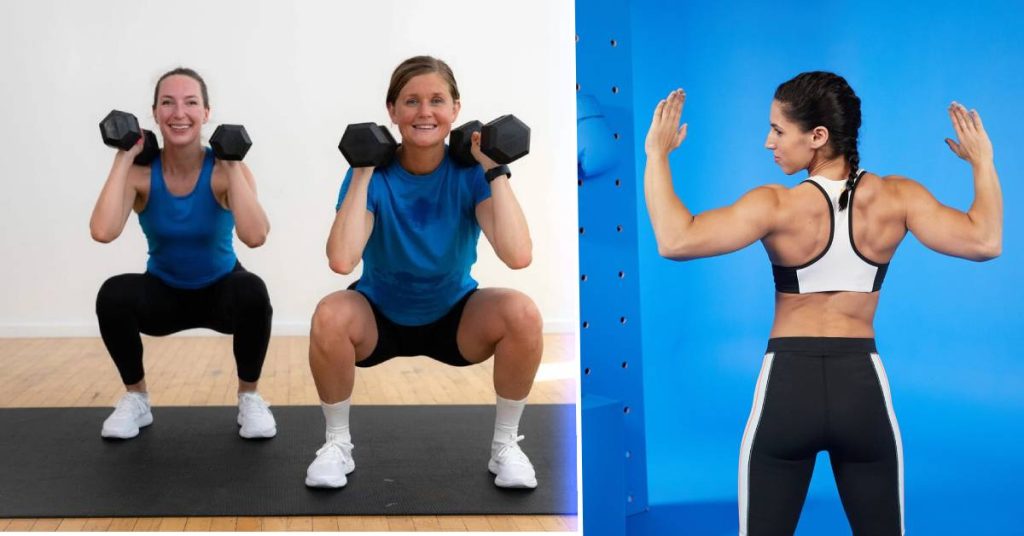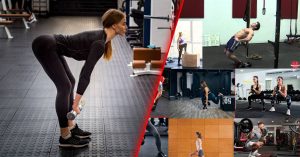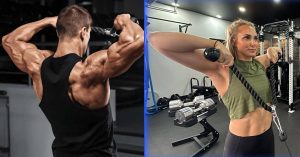Strength training, often in the shadow of cardio, is the unsung hero of women’s fitness. It stands as a beacon of transformation, not just for the body, but for the mind and spirit too. Beginner strength training for women paves the way for stronger muscles, denser bones, and a confidence that shines through every facet of life.
But where do you start? And what is it about weight lifting that brings such transformative effects for women? Let’s dive deeper into the essence of strength training and discover its unmatched benefits.
Table of contents
MORE keyboard_double_arrow_down LESS keyboard_double_arrow_up
What Exactly Is Weight Training?
Weight training is a way to get stronger by lifting things. Imagine picking up dumbbells, kettlebells, or even a heavy backpack. It’s all about using something heavy to challenge your muscles.
Now, some folks mix up weight training with strength training or resistance training. They’re like cousins in the fitness world. While they all help you get stronger, weight training specifically means you’re using extra weights or objects. But here’s the cool part – beginner strength training for women includes all these types to make you stronger and fitter.
Is It the Same for Women and Men?
Here’s a big question: Do women need to train differently than men? Absolutely not! The experts at the National Association of Strength and Conditioning (NSCA) say everyone can train in the same way. Why? Because muscles work the same in all of us, no matter if you’re a guy or a girl.
However, although the training doesn’t need to change, there might be times, like when a woman is pregnant or just had a baby, where she might need to tweak her workouts. So, while beginner strength training for women follows the same principles as men’s training, it’s flexible to fit everyone’s needs.
What Do Experts Say About Strength Training For Women?
There is no doubt that strength training poses many benefits for women. But what exactly do experts in the field say about this? Let’s take a look.
According to Dr. Miriam E. Nelson, a leading expert in the field of women’s health and author of “Strong Women Stay Young,” strength training plays a crucial role in enhancing bone density and reducing the risk of osteoporosis in women. Weight-bearing exercises, such as lifting weights, have been shown to stimulate bone growth and help prevent bone loss, particularly important for women as they age.
Furthermore, Dr. Wayne Westcott, a prominent fitness researcher and author of “Strength Training Past 50,” emphasizes that strength training can significantly boost metabolism, leading to increased calorie burning even at rest. This is particularly beneficial for women seeking to manage their weight and improve body composition.
Also, Dr. Maria Fiatarone Singh, a geriatric medicine specialist and researcher at the University of Sydney, emphasizes that strength training is essential for promoting healthy aging in women. It helps maintain muscle mass, mobility, and independence as individuals grow older.
And lastly, take a look at this Instagram post by Kate Whetsel a Fitness & Lifestyle Coach for Women in Perimenopause & Beyond where she states why it’s important for women over 40 to focus on strength training.
Why It's Never Too Late to Start
Embarking on a strength training journey can seem daunting. Yet, it’s a voyage that promises rewards at every turn. Beginner strength training for women is not solely about lifting weights; it’s about building a foundation for a life brimming with vitality and health. The advantages are vast:
- Enhanced Muscle Tone: Achieving a toned body is a common goal for many, and strength training directly contributes to this by building lean muscle mass.
- Boosted Metabolic Rate: With more muscle comes a higher metabolism, meaning your body burns more calories, even at rest.
- Improved Posture and Bone Health: Regular weight lifting strengthens the skeletal system, improving posture and lowering the risk of osteoporosis.
- Reduced Risk of Chronic Diseases: Engaging in strength training can decrease the risk of heart disease, diabetes, and more.
If you’re wondering whether it’s too late to start, let’s clear the air: it’s never too late. Strength training holds significant benefits for women of all ages, showcasing that the journey to a stronger self can begin at any point in life.
But as you stand at the threshold of this path, you may wonder—how do you take the first step? The answer lies in understanding the basics, crafting a plan tailored to your goals, and embracing the journey with an open heart. And so, the adventure begins, filled with promise and potential.
Stay tuned as we unveil the secrets to starting strong, staying motivated, and transforming your life through the power of weight lifting. The journey ahead is paved with challenges, but the rewards are immense. Are you ready to discover the strength within you? Let’s begin.
Laying the Groundwork for Success
Embarking on the path of women weight lifting is not a journey of random actions; it’s a methodical process aimed at building your strength in a structured manner.
Before diving into the world of weights and reaping its multitude of benefits, grasping the basics is essential. This includes understanding the various forms of strength training, selecting the correct weights, and mastering the proper form.
First and foremost, let’s break down the essentials:
- Know that strength training encompasses more than just lifting weights; it includes bodyweight exercises, resistance band workouts, and more.
- It’s crucial to start with weights that challenge you without compromising your form.
- Proper form is the key to preventing injuries and maximizing the effectiveness of your workouts.
- Focusing on exercises that target different muscle groups ensures a balanced and holistic strength development.
- Rest and recovery are just as important as the workouts themselves, allowing your muscles to heal and grow stronger.
As we delve deeper, we’ll explore the practical application of these principles, guiding you through the process of integrating strength training into your life.
But remember, the journey to strength is not just about the physical transformation—it’s about discovering your inner power and resilience. Are you ready to take the next step and unlock your full potential?
The First Steps To Starting Weight Training
Embarking on weight training can feel like a leap into the unknown, but it’s a leap worth taking. Here’s how you can start off:
Find Your Guide
Starting with a coach can make all the difference. They’re not just there to help you lift; they’re your safeguard against injury and your shortcut to success. Beginner strength training for women often starts here, with expert guidance to build your confidence and competence.
Join the Community
Ever thought about group classes? They’re more than just workouts; they’re your entry into a community. Each class is a chance to learn, grow, and connect, making beginner strength training for women a shared adventure.
Train on Your Turf
Prefer the comfort of your home? That works too! With basic gear like dumbbells, you can kick off your strength journey where you’re most comfortable. Home is where many women find their strength, starting their beginner strength training for women path.
Plan for Progress
Success in weight training comes down to a good plan. Look for one that challenges you gradually and keeps you safe with rest days and proper recovery. This strategic approach is key for beginner strength training for women, setting the stage for steady gains.
Keep It Simple
Remember, starting simple is smart. You don’t need to max out from day one. Enjoy the journey of building strength bit by bit, and celebrate the gains as they come.
Ideal Weight Training Exercises for Women
Now that you know how to start off, here are some of the most ideal weight training exercises you can try, with something for every muscle group. Remember, it’s okay to start with modifications and work your way up:
- Chest: Push-ups, bench press
- Shoulders: Overhead press, lateral raises
- Arms: Biceps curls, triceps extensions
- Back: Pull-ups, bent-over rows
- Core: Planks, dead bugs
- Legs: Squats, lunges
- Glutes: Glute bridges, hip thrusts
Full-Body Weight Training Workout Ideal For Women
Give this full-body workout a go—it’s tailor-made for women and all you need is a pair of dumbbells. We’re talking about supersets here, a fancy term for doing two exercises back-to-back before catching your breath.
Start with Superset 1 (aim for 2-3 sets): Kick it off with goblet squats (hold a dumbbell in both hands close to your chest) for 12 reps, then smoothly transition to bent-over rows for another 12 reps. Rest for a minute after the rows.
Now, onto Superset 2 (again, 2-3 sets): Try suitcase lunges (12 reps, 6 each side, holding a dumbbell in each hand) followed by 12 reps of overhead press. Take a rest for a minute after the presses.
Last but not least, Superset 3 (yup, 2-3 sets): Hit 12 reps of dumbbell chest press, then seamlessly move on to 12 reps of glute bridges (with a dumbbell against your hips). Rest for a minute after the bridges.
Remember, between each superset, give yourself a solid 2 to 3-minute break. This workout isn’t just about gaining muscle; it’ll also get your heart pumping thanks to the higher-volume reps.
Bodyweight Strength Training Workout
Now, if you don’t have any weights lying around, fret not! You can still get strong with this bodyweight strength workout using the same superset style.
Superset 1 (again, 2-3 sets): Nail 5 standard push-ups (or 10 modified ones) followed immediately by 10 squats with a 3-second descent and a 1-second pause at the bottom. Take a 45-second breather between sets.
Moving on to Superset 2 (you guessed it, 2-3 sets): Hold a 30-second plank and then bust out 16 reps of reverse lunges (8 each leg) with a 1-second pause at the bottom. Rest for 45 seconds between sets.
And finally, Superset 3 (you got it, 2-3 sets): Crush 5 close-grip push-ups (or 10 modified ones) targeting those triceps, followed by a 30-second glute bridge hold. Rest for 45 seconds between sets.
Just like the first workout, take a decent 2 to 3-minute break between each superset. It might feel like cardio, but trust me, it’s sculpting those quads, hamstrings, chest, and more. Give it a shot!
Tips for Safe and Effective Training
Diving into beginner strength training for women is an exciting venture, yet safety should always be a top priority. So, here are some key tips to keep in mind:
- Proper Warm-Up: Starting your session with a warm-up prepares your muscles and joints, reducing the risk of injuries.
- Maintaining Proper Form: This is crucial for effective training and preventing injuries. Understanding the mechanics of each exercise ensures you’re working the intended muscle groups without strain.
- Progressive Overload: Gradually increasing the intensity of your workouts is essential for continuous improvement. This strategy keeps your muscles challenged, fostering growth and strength gains.
Adhering to these guidelines ensures your journey into women weight lifting is not just exhilarating but also secure and productive.
Separating Fact from Fiction in Strength Training
It is not surprising that there are many myths when it comes to women in strength training. Below are some common myths and answers to them:
Myth: Strength training will make women bulky.
This is a common misconception. Strength training actually helps women build lean muscle and increase metabolism, leading to a toned and sculpted physique.
Myth: Strength training is not safe for women.
When done with proper form and technique, strength training is safe and can help prevent injuries by strengthening muscles and bones.
Myth: Women should avoid heavy lifting during pregnancy.
With proper guidance from a healthcare professional, pregnant women can safely engage in moderate strength training to maintain muscle tone and overall health during pregnancy.
Myth: Women should use lighter weights and do more reps.
Women can benefit from lifting heavier weights with lower reps to build strength and muscle mass effectively.
Final Thoughts
As we bring this guide to a close, it’s crucial to reflect on the essence of beginner strength training for women. Our exploration has not only highlighted the physical benefits of lifting weights but also emphasized the journey towards discovering and unleashing your inner strength.
This adventure is a testament to the transformative power of resilience, dedication, and self-belief. Every lift, every rep, and every set you complete is a step closer to a more empowered version of yourself.
Strength training opens up a world of discovery, not just about the limits of your physical capabilities but also the resilience of your spirit and the power of your determination. With the knowledge you’ve gained, the myths you’ve seen debunked, and the insights you’ve acquired, you’re now equipped to embark on this journey with a sense of readiness and excitement.
Key Points
- Strength training is essential for women’s fitness, contributing to stronger muscles, denser bones, and increased confidence.
- It plays a significant role in transforming not only the body but also the mind and spirit.
- Definition of Weight Training:
- Weight training involves getting stronger by lifting objects such as dumbbells, kettlebells, or other heavy items.
- It differs from strength and resistance training, as it specifically includes the use of additional weights or objects.
- Women do not need to train differently than men; muscles work the same way in both genders.
- While the principles remain the same, flexibility is allowed for specific needs, such as during pregnancy or postpartum.
- Benefits of strength training for women include enhanced muscle tone, increased metabolic rate, improved posture, and reduced risk of chronic diseases are among the benefits.
- Strength training requires a methodical approach, understanding various forms, selecting appropriate weights, maintaining proper form, targeting different muscle groups, and prioritizing rest and recovery.
- The first steps in strength training include starting with a coach, joining a community, training at home, planning for progress, and keeping it simple are recommended steps.
- Exercises targeting various muscle groups, including chest, shoulders, arms, back, core, legs, and glutes, are recommended.
- A full-body workout with dumbbells is provided, emphasizing supersets for muscle engagement and cardiovascular benefits.
- A bodyweight workout is suggested for those without weights, emphasizing superset style for effectiveness. It includes push-ups, squats, planks, lunges, and glute bridges.
- Proper warm-up, maintaining proper form, and progressive overload are essential for safe and effective training.
FAQs
What are the best strength training exercises for beginners?
Discover exercises that lay the foundation for building strength across major muscle groups.
How can I overcome plateaus in my training?
Learn strategies for adjusting your workout plan to continue making progress.
What’s the ideal frequency for strength training?
Find out how often you should train to optimize results while allowing for adequate recovery.
References

ABOUT THE AUTHOR
Follow Valen Steven for a dose of fitness enthusiasm, evidence-based advice, and a roadmap to achieving your health and wellness goals.
Subscribe to our Newsletter
Dive into a world of fitness and wellness with our exclusive newsletter! Sign up now and receive weekly power-packs of fitness wisdom




